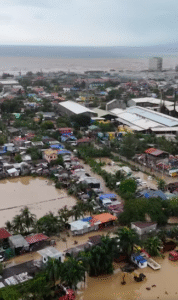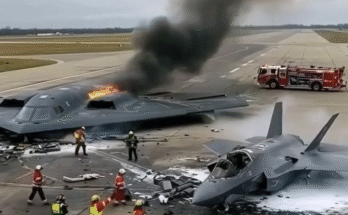Typhoon Kalmaegi Kills at Least 85 in the Philippines, Heads Toward Vietnam
In early November 2025, Typhoon Kalmaegi, known locally in the Philippines as “Tino,” struck the central Philippines with devastating force, leaving at least 85 people dead, dozens missing, and hundreds of thousands displaced. The storm, which brought torrential rain, strong winds, and flash floods, has since moved into the South China Sea, with authorities in Vietnam and neighboring countries bracing for further impact. The disaster has highlighted not only the destructive power of extreme weather but also the vulnerability of communities still recovering from previous calamities.
The Path of Destruction
Typhoon Kalmaegi originated in the western Pacific and entered the Philippine Area of Responsibility under the local name Tino. It made landfall across central provinces, including Cebu, Bohol, Leyte, and parts of Mindanao, causing catastrophic flooding and widespread damage. The storm struck when rivers were already swollen and the ground saturated from recent rains, exacerbating its impact. Meteorologists reported that Kalmaegi brought sustained winds of approximately 130 kilometers per hour, with gusts reaching up to 180 kilometers per hour. Intense rainfall led to flash floods, landslides, and infrastructure collapse, leaving communities scrambling to escape rising waters.
The typhoon’s timing worsened its consequences. Many of the affected provinces were still recovering from previous disasters, including a powerful earthquake in September that had damaged infrastructure and displaced thousands. With weakened structures and already vulnerable communities, Kalmaegi’s arrival proved particularly destructive. The combination of heavy rainfall, saturated soil, and poor drainage created an environment where flash floods and landslides could occur almost instantly, catching many residents off guard despite evacuation efforts.
Human Toll and Immediate Impact
The human cost of the storm has been staggering. At least 85 people have been confirmed dead, with more than 70 still missing. Many fatalities occurred due to drowning in flash floods, landslides, and structural collapses, while others were the result of accidents during evacuation and rescue operations. In one tragic incident, a Philippine Air Force helicopter crashed while assisting relief operations in Mindanao, killing six military personnel. Entire communities were submerged, and many homes were either swept away or severely damaged.
More than 387,000 people were evacuated ahead of the typhoon, seeking shelter in designated evacuation centers. While these measures undoubtedly saved lives, the scale and speed of the flooding meant that many residents were trapped or forced to climb onto rooftops to escape the rising waters. Reports described rivers overflowing their banks, bridges washed away, roads submerged, and vehicles carried away by powerful currents. In Cebu province, dozens of residents drowned in floodwaters, and countless families lost their homes and livelihoods.
Infrastructure and Environmental Factors
Several factors contributed to the severity of the disaster. In some areas, deforestation and quarrying had clogged rivers and drainage systems, reducing the land’s ability to absorb heavy rainfall. Many communities are built near rivers and coastal areas without adequate flood control infrastructure, making them especially vulnerable to extreme weather events. In addition, weak or poorly maintained roads and bridges complicated evacuation and rescue efforts, leaving some communities isolated during the storm.
The speed of the flooding compounded the danger. Even with early warnings, residents in hilly or low-lying areas had little time to react as waters rose rapidly. In urban centers, drainage systems became overwhelmed, leading to inundation of streets and homes. The combination of environmental degradation, infrastructure gaps, and extreme weather created a perfect storm of vulnerability.
Response and Relief Efforts
In the immediate aftermath of Kalmaegi, local and national authorities mobilized emergency response teams to conduct search and rescue operations, provide medical care, and distribute food, water, and shelter to affected communities. Cebu province declared a state of calamity to expedite the release of funds for relief and rehabilitation, enabling authorities to support displaced residents and begin clearing debris from roads, homes, and public spaces.
Humanitarian agencies and community volunteers joined the effort, assisting families stranded by floods and landslides. Medical teams worked to prevent disease outbreaks in evacuation centers, while local governments coordinated with national authorities to ensure that the most affected areas received urgent attention. Despite these efforts, access to some remote or heavily flooded areas remained difficult, delaying rescue operations and the delivery of essential supplies.
The Regional Outlook
After devastating the Philippines, Kalmaegi moved toward the South China Sea and is forecast to make landfall in parts of Vietnam, where authorities are preparing for heavy rainfall, flooding, and landslides. Coastal communities have been warned, and evacuations have been implemented for residents in high-risk areas. Fishing boats and maritime traffic have been advised to remain in port as authorities prepare emergency shelters and stockpile supplies.
The potential impact in Vietnam raises concerns about a compound disaster scenario. Communities still recovering from previous storms may face similar vulnerabilities, and the rapid succession of extreme weather events highlights the need for resilient infrastructure, early warning systems, and effective disaster preparedness plans across the region.
Broader Implications
Kalmaegi’s devastation underscores the persistent vulnerability of Southeast Asian countries to extreme weather events. The Philippines, in particular, is one of the most disaster-prone nations in the world, regularly facing typhoons, earthquakes, and volcanic activity. Experts warn that climate change is intensifying tropical storms, bringing heavier rainfall and stronger winds, which increase the risk of flooding and landslides.
The storm also highlights the intersection of human settlement patterns, environmental degradation, and infrastructure inadequacies. Many affected communities were located in flood-prone areas or near rivers, and deforestation and poor land management exacerbated the flooding. Kalmaegi serves as a reminder of the urgent need for sustainable development, improved urban planning, and strengthened environmental protections to reduce the impact of future storms.
Human Stories of Resilience
Amid the devastation, stories of resilience and solidarity have emerged. Residents have helped neighbors evacuate, shared resources in shelters, and supported one another through trauma and loss. First responders and volunteers have worked tirelessly to rescue stranded families and distribute aid. Despite the profound loss, communities are coming together to rebuild, demonstrating strength and solidarity in the face of adversity.
Families who lost homes are now relying on temporary shelters and support from local governments and humanitarian organizations. Many are beginning to assess the damage to livelihoods, crops, and businesses. The long-term recovery will involve not only rebuilding homes and infrastructure but also restoring communities’ sense of security and stability.
Moving Forward
The aftermath of Typhoon Kalmaegi is a stark reminder of the need for comprehensive disaster preparedness and resilience strategies. Improving infrastructure, maintaining natural flood defenses, and implementing early warning systems are critical steps to protect vulnerable populations. Social support networks and mental health resources are equally important, as survivors cope with the trauma of losing loved ones, homes, and livelihoods.
Regional cooperation will be essential as the storm continues toward Vietnam and other neighboring countries. Sharing resources, expertise, and early warning information can help minimize casualties and damage. At the community level, continued education about disaster preparedness, evacuation plans, and the risks associated with extreme weather can save lives in future events.
Conclusion
Typhoon Kalmaegi has left a trail of destruction across the Philippines, taking at least 85 lives and displacing hundreds of thousands. It has revealed the fragility of communities still recovering from previous disasters and the urgent need for stronger infrastructure, better disaster planning, and climate adaptation strategies. As the storm moves toward Vietnam, authorities and communities remain on high alert, preparing for further impact.
While the loss is immense, the response demonstrates the resilience and solidarity of affected populations. Recovery will be a long and challenging process, but the courage and determination of communities, first responders, and volunteers provide hope that life will be rebuilt. Kalmaegi is a reminder of the power of nature and the importance of preparedness, planning, and cooperation to protect lives in a changing climate.


